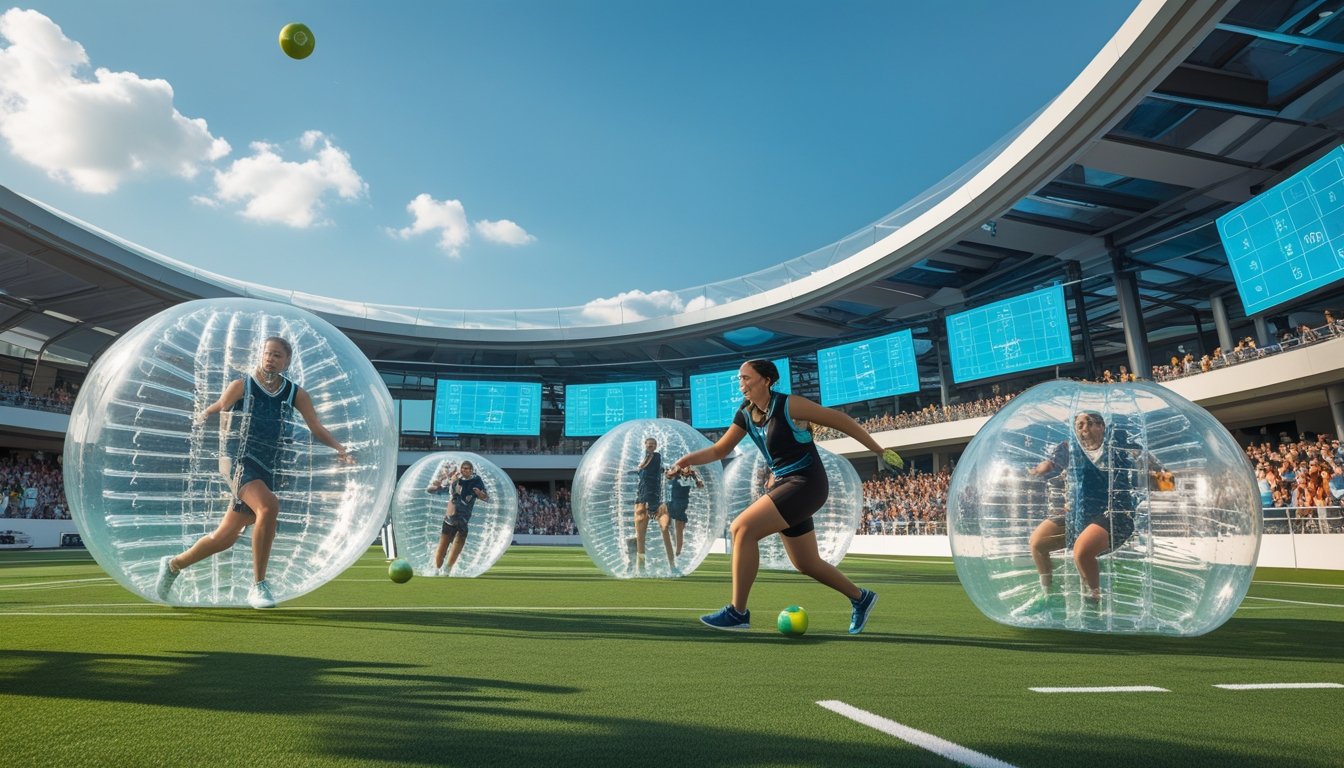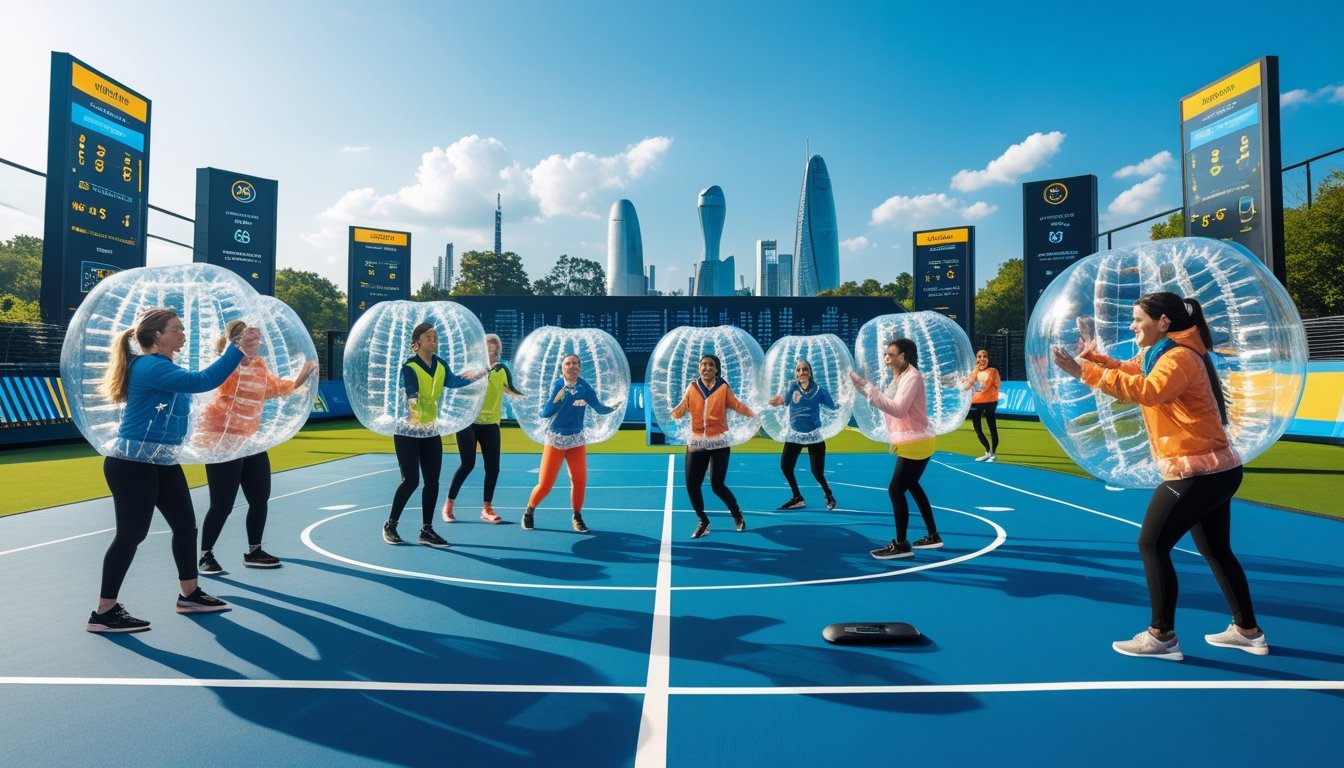Late updated: 05 Jun 2025 09:06
Written by: Emma Saunders
The Future Of Bubble Sports Innovations: Cutting-Edge Trends and Developments
Bubble sports innovations are transforming the landscape of recreational and professional activities. From the strategic use of technology to enhance gameplay to engaging spectators through virtual and augmented reality, the future of bubble sports is marked by exciting evolution. Technology is revolutionising the way bubble sports are played and experienced, making them more interactive and immersive than ever before.

As we explore the advancements in bubble sports, it becomes clear that these innovations are reshaping our interaction with traditional sports. The introduction of bubbleball in soccer, for instance, showcases a shift towards more engaging and safer sporting experiences. Integrating modern technology offers dynamic opportunities for both players and fans to participate in new ways.
The landscape of bubble sports continues to evolve, and these innovations herald a future where sports are not only about physical engagement but also about digital and virtual interactivity. Our exploration promises insights into how these changes are setting new standards in the sporting world, inspiring both amateur enthusiasts and seasoned professionals.
Key Takeaways
- Bubble sports are being transformed by technological advancements.
- Integration of virtual elements is enhancing player and spectator experiences.
- Innovations in bubble sports are redefining traditional sporting activities.
Innovative Advancements in Bubble Sports
Exploring the developments in bubble sports, we observe a significant transformation driven by emerging technologies, strategic use of air-supported structures, and the potent influence of social media and storytelling.
Emerging Technologies in Bubble Sports
In bubble sports, technology has redefined gameplay and viewer engagement. Augmented reality (AR) is enhancing interactions, allowing players to access strategic overlays during matches. Integrating virtual reality (VR) offers immersive experiences for fans, letting them participate from home as if they were in the stadium. AI-driven analyses provide coaches with real-time data, uplifting strategies and performance.
These technologies collectively boost audience participation and improve player tactics, ensuring bubble sports remain at the cutting edge of innovation.
Impact of Air Domes and Air-Supported Structures
Air domes have revolutionised the infrastructure of bubble sports by providing flexible, climate-controlled environments. These structures ensure year-round play irrespective of weather conditions, addressing the unpredictabilities that outdoor venues face. With energy-efficient designs, air-supported structures reduce operational costs for sports facilities.
Air domes also allow for quick setup and takedown, making them versatile for different sports and events. Their use signals a shift towards modern, adaptable sports environments in the industry.
Role of Social Media and Storytelling
Our engagement with social media has transformed the way bubble sports connect with audiences. Platforms like Instagram and TikTok highlight storytelling through player narratives and behind-the-scenes content. This direct access to players' personal stories builds community and loyalty, reaching audiences globally.
Social media channels also enable real-time fan interactions, reshaping how enthusiasts experience bubble sports. This storytelling approach not only markets the events but also enhances fans' emotional connection with teams and players, keeping them deeply engaged and invested.
The Future Landscape of Bubble Sports

As we peer into the future of bubble sports, it becomes evident that the dynamics of sponsorships, athlete opportunities, and market expansion are evolving. These changes will shape how bubble sports interact with the broader sports industry.
Changing Sponsorships and Funding Models
Sponsorships will likely play a pivotal role in the future of bubble sports. Companies are beginning to see the potential in reaching audiences through non-traditional sports. This shift could result in increased capital flowing into bubble sports, enabling more robust events and improved facilities.
The prominence of organisations like Athletes Unlimited and their innovative funding approaches offer a blueprint for success. These models focus on direct engagement with fans, which could further elevate bubble sports' profile.
Expanding Opportunities for Athletes
The future of bubble sports holds significant promise for athletes. As these sports grow, they offer new platforms for athletes to showcase their talents. Innovative leagues, inspired by formats like the National Women’s Soccer League, provide athletes with competitive yet flexible options to engage with fans.
Investment in athlete development programmes will become a priority. By fostering talent at grassroots levels and providing pathways to professional competitions, more athletes will be drawn into the exciting world of bubble sports.
Bubble Sports and the Broader Sports Market
Bubble sports are carving out a unique place in the broader sports market. By leveraging the interest in unconventional and engaging formats, these sports are attracting new spectators. They are no longer seen as mere novelties but as formidable competitors in the sporting landscape.
Gaoshan's entry into bubble sports exemplifies the potential growth, demonstrating how international players are taking notice. Collaborations between traditional sports leagues and bubble sports can create synergies, enhancing viewership and participation across various channels.
As we explore these shifts, it's clear that bubble sports are poised to influence the conventional sports sector significantly. By capitalising on these opportunities, bubble sports can become a mainstream attraction, reshaping the landscape of sports entertainment.
Frequently Asked Questions

We will explore the transformative impact of technology on bubble sports, focusing on sectors such as player safety, athlete training, and fan engagement. As tech continues to evolve, its integration into sports promises to reshape everything from equipment quality to strategic development.
How will technological advancements impact player safety in contact sports?
Technological innovations are making equipment safer through enhanced materials and smart textiles, which help monitor players' biometrics. These advances aim to reduce injury risks and ensure a safer playing environment. Sensor-equipped gear can track vital statistics in real-time.
What role will virtual reality play in training regimes for professional athletes?
Virtual reality is becoming a vital tool for sports training. It provides immersive environments where athletes can practice scenarios and refine techniques without physical strain. This technology helps in injury prevention and performance analysis by offering a detailed breakdown of movements and tactics.
In what ways could advancements in material science enhance sports equipment?
Material science contributions are significant, providing lighter, more durable materials for sports gear. Improvements in polymers and composites lead to equipment that's both resistant and flexible, catering to high-impact sports. These innovations significantly enhance athlete comfort and performance.
How is augmented reality expected to alter the fan experience in stadiums?
Augmented reality is set to transform live sports events by enhancing fan engagement. It can provide interactive experiences via mobile devices, offering real-time statistics, player backgrounds, and immersive replays. This technology promises a richer, more personalised experience for fans.
What are the potential effects of AI on sports coaching and strategy development?
Artificial intelligence is becoming crucial in analysing player performance and developing game strategies. It processes vast data to offer insights on player behaviour, match outcomes, and potential improvements. AI helps coaches tailor training programmes that maximise an athlete’s strengths.
How might data analytics evolve to improve team performance across various sports?
Data analytics is a game changer in sports, enabling in-depth performance reviews. Advanced algorithms help in identifying patterns and areas for improvement. Teams use analytics to refine tactics, adjust training loads, and optimise player rotations to achieve peak performance.
